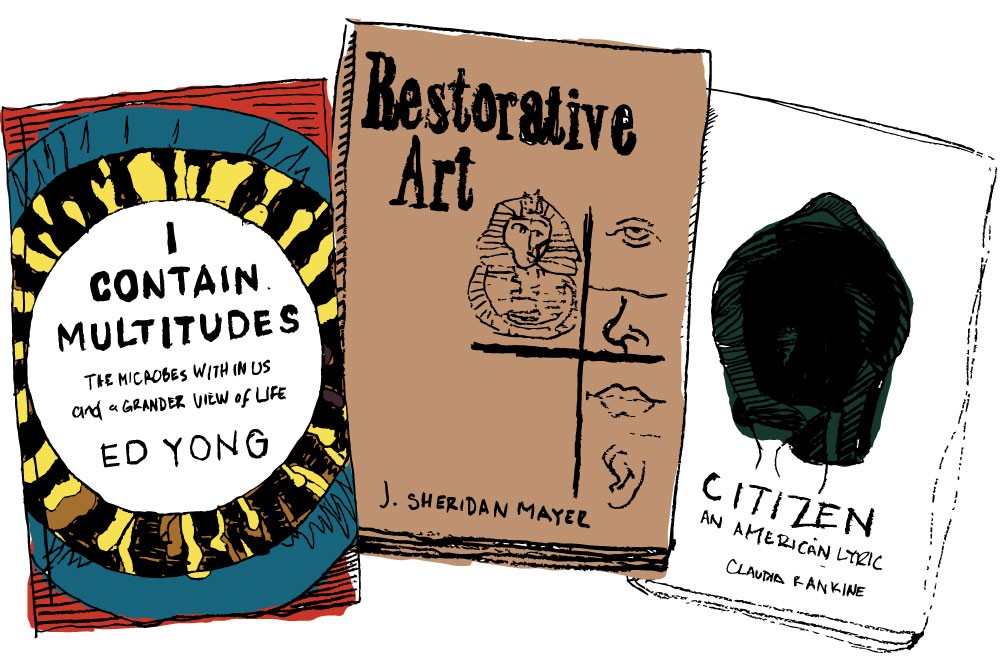You know how sometimes you’re shopping in the University of Minnesota bookstore and you see a book that looks fabulous, but you know you’ll never be able to fit that class into your schedule? We have you covered — just don’t forget to bring your U-Card to checkout.
“Citizen” by Claudia Rankine
Class: Literature and Public Life (English 1501W)
Published by Minnesota’s own Graywolf Press, this poetry collection was dubbed “relevant” by the New York Times upon its release in 2014. Commenting on racial aggression in the United States and divided into seven chapters with topics ranging from Serena Williams to police shootings and the motif of the hoodie, it’s still relevant. Surprise, surprise.
“The Yamas & Niyamas” by Deborah Adele
Class: Hatha Yoga Philosophy, Lifestyle and Ethics (Center for Spirituality and Healing 4312)
Deborah Adele’s slim little number is best read when you’re feeling inspired — like on a day when you finally turn all the brown bananas in your freezer into a smoothie. Covering the first two parts of the eight-fold path of the Yoga Sutras, “The Yamas & Niyamas” offers guidelines for individuals to “take control of their life.” And with instruction to ponder at the end of each chapter, you might just teach yourself something.
“I Contain Multitudes” by Ed Yong
Class: Antibiotic Resistance: How Can We Avoid the Apocalypse? (Grand Challenge Curriculum 3016)
Called “science journalism at its best” by Bill Gates, Ed Yong’s “I Contain Multitudes” tells us how microbes mold our minds and bodies. Did you know that our microbes overwrite a new home within 24 hours of moving in? Good luck finding a subletter for summer.
“Pippi Longstocking” by Astrid Lindgren
Class: Children’s Literature in Scandinavia (Scandinavian 3613)
Oh, you wore the costume for Halloween when you were little, but haven’t read the book? Fake fan! Jump into the world of Pippilotta Delicatessa Windowshade Mackrelmint Ephraim’s Daughter Longstocking with Astrid Lindgren’s Swedish classic. Maybe the strongest girl in the world will inspire you to hit the rec.
“Restorative Art” by J. Sheridan Mayer
Restorative Art (Mortuary Science 3051)
Ever wanted to learn how to prepare a body after death? Probably not. But isn’t it nice to know you can? Everyone on the internet says they’ve been looking for this book forever since losing their copy, so it’s pretty cool that the bookstore sells it. The linen cover is really pretty, too.
“Selfish” by Kim Kardashian
Reading Culture: Theory and Practice (Cultural Studies and Comparative Literature 1301W)
This book comprises Kimberly Noel Kardashian West’s selfies, and it’s glorious. With photo evidence of the time West had a terrible sunburn, “surprise” shots for Kanye and memorialized 2006 hangouts with Paris Hilton, the only downside is that Chicago isn’t featured yet (you’ll have to buy the updated copy next year).
“Why We Buy” by Paco Underhill
Retail Environments and Human Behavior (Retail Merchandising 4117W)
Did you buy new Pilot G2’s this semester in the hopes they’d inspire you to take better notes? Paco Underhill helps us understand our consumption, detailing internet buying habits (I see you, neighbors with new Amazon Prime orders every day), tips for enticing customers and information on the most innovative stores around the world. Cha-ching.
“Between the World and Me” by Ta-Nehisi Coates
Puzzles in World Politics (Political Science 1054)
Written as a letter to the author’s son, Ta-Nehisi Coates’ 2015 autobiography is required reading for at least six University classes. Inspired by a too-respectful meeting with Barack Obama and James Baldwin’s “The Fire Next Time,” Coates meditates on growing up black in America – and everything that comes with it.
“Fun Home” by Alison Bechdel
History through Memoir (History 3284W)
Based on her childhood journals, famed comic-illustrator and creator of the “Bechdel test” Alison Bechdel’s “Fun Home” is a graphic memoir more real than cutesy. “The writer’s business is to find the shape in unruly life and to serve her story,” writes Bechdel. “Not, you may note, to serve her family or to serve the truth, but to serve the story.”
“The Design of Everyday Things” by Don Norman
Human Factors in Design (Design 5185)
Any good product — any good anything really — requires good design. But what makes one product easy to use and one absolutely horrible? Originally released in 1988, “The Design of Everyday Things” is still an Amazon bestseller. Why do you care less about one reusable water bottle getting lost on a Friday night than you do another? You’ll never look at a BlenderBottle the same way again.








